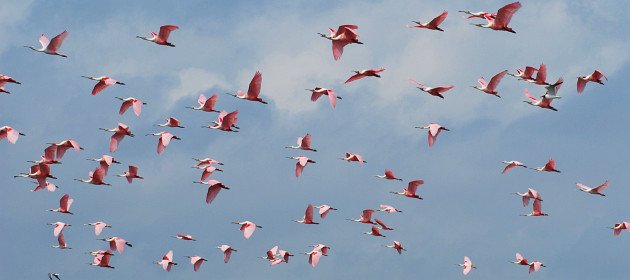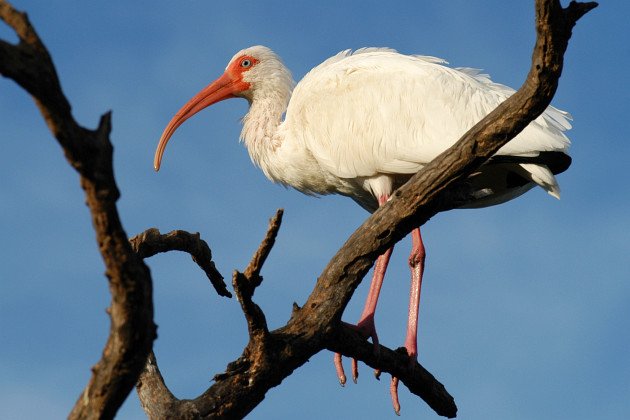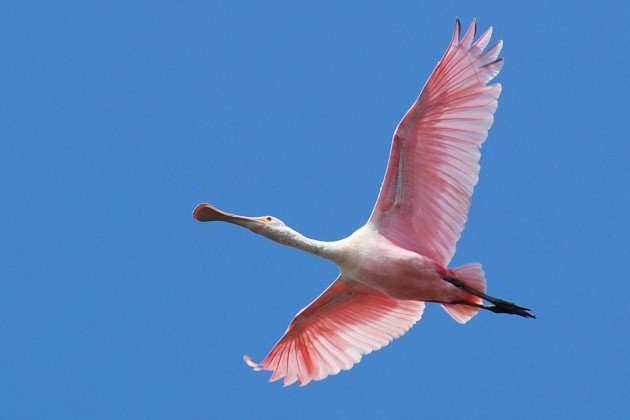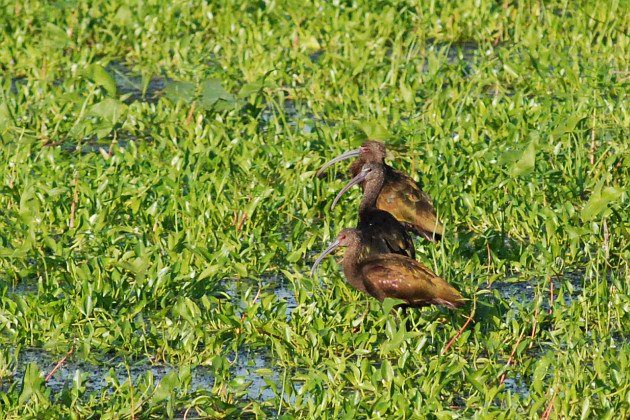
Spoonbills and ibises are stocky, colorful wading birds with distinctive bills: downcurved and pointed in the case of ibises, flat and paddle shaped in the spoonbills (above is my shot of Roseate Spoonbills (Platalea ajaja) near a breeding colony in Louisiana). Together, they are placed in the family Threskiornithidae, and they’re related to herons and egrets, pelicans, and the strange Hamerkop and Shoebill.

White Ibis (Eudocimus albus) in Florida © David J. Ringer
The American Ornithologists’ Union recognizes two subfamilies, one for ibises (Threskiornithinae) and one for spoonbills (Plataleinae). As I’ve written before, bill shape was often used to classify birds, but genetic studies are revealing that bill shape is a fairly poor predictor of relatedness.
A new study out on the spoonbills and ibises confirms what a handful of others have indicated over the years: There are two branches in the ibis-spoonbill family, but the division is not between the curve-bills and the paddle-bills (PDF: Molecular phylogeny of Threskiornithidae (Aves: Pelecaniformes) based on nuclear and mitochondrial DNA).
Instead, the division — which the authors Ramirez et al. hypothesize originated during the breakup of Gondwana — lies between an “endemic New World clade” and a “widespread clade,” with the spoonbills nested in the “widespread clade” near the Old World Threskiornis ibises.

Roseate Spoonbill (Platalea ajaja) in Louisiana © David J. Ringer
The New World clade includes the closely related White and Scarlet ibises, the Black-faced Ibis and its kin, and the Bare-faced Ibis.
The “widespread” clade occurs throughout the Old World and has apparently colonized the Americas several times. In addition to the spoonbills, which occur on every continent except Antarctica, this group contains the sacred ibises, the noisy East African Hadada Ibis, and the weird and wonderful Waldrapp.

White-faced and Glossy ibises (Plegadis chihi and P. falcinellus) in Mississippi © David J. Ringer
The “widespread” clade also includes the Plegadis ibises, one of which — the Glossy Ibis — is globally distributed but apparently a relative newcomer to the Americas. The other two living species, the Andean Puna Ibis and the White-faced Ibis occur in the Americas. Interestingly, Ramirez et al. found in some analyses that a South American White-faced Ibis was not sister to a North American White-faced Ibis. A cryptic species? Looks like we’ll have to wait for further studies.
Meanwhile, perhaps the AOU will now have enough published evidence to revise its subfamily treatment of this interesting family. Spoonbills, it seems, are ibises with big flat bills.













Interesting post. Our Yellow-billed and Royal Spoonbills do feed with Australian White Ibis at times, and can be hard to tell apart from a distance if you can’t see the bill. It wouldn’t be so with Straw-necked or Glossy Ibis though normally.
Very cool research. Thank you for sharing.